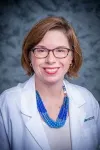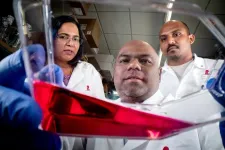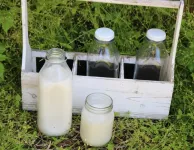(Press-News.org) BIRMINGHAM, Ala. – Memory immune cells reside in many tissues, poised to react to a second infection or continuing antigen. Yet little is known about these tissue-resident memory cells — how they get there, how they evolve and how they compete in tissues.
A five-year, $18.5 million grant will allow University of Alabama at Birmingham researchers to investigate T and B tissue-resident memory cells, known as TRM and BRM cells, in three unique sites — transplanted lungs, transplanted kidneys and the transplanted uteruses of UAB patients. The transplants permit researchers to study memory cells in tissue over time, learning how the cells ended up there, whether they will stay or go, how they might differentiate and what role their progeny will play.
Donor tissue transplants from another person are new, non-self environments that require immunosuppressant therapy for the recipient. Periodic samples from the transplants will allow UAB project directors Fran Lund, Ph.D., Paige Porrett, M.D., Ph.D., and Troy Randall, Ph.D., to address the central hypothesis of their grant — “that the human immune memory compartment is constantly evolving in response to tissue-specific and antigen-specific signals that influence the durability and programming of those cells,” as they write in their research strategy.
Often studies of immune responses in humans are like taking a snapshot photo — interesting and memorable, but lacking enough context to fully understand what is happening, Lund says. Similarly, Randall says, many longitudinal immunology studies have looked at immune cells by taking serial draws of peripheral blood. Yet it is in the transplant tissue, not the blood, where immune rejection occurs.
“To move beyond the snapshot approach for studying immune responses, we have developed methods to comprehensively track clonally related lineages of antigen-specific B and T cells over time, both in circulation and in tissues,” Lund said. “We will use these methods to address fundamental questions about the generation, evolution and durability of antigen-specific B and T cell responses in transplant recipients.”
This research grant — awarded to UAB as part of the National Institutes of Health program titled Cooperative Centers on Human Immunology — will focus on better understanding the fundamental processes that regulate BRM and TRM cells. Indirect benefits that might evolve from the work include how to block immune rejection of transplanted lungs and kidneys; understanding the phenomenon of “immune tolerance” in the uterus, where the immune response is dampened to protect the non-self fetus during pregnancy; or learning how to lessen the damage caused by auto-immune diseases such as lupus, psoriasis, inflammatory bowel disease or Type 1 diabetes.
Data from preliminary work to support UAB’s grant application to the National Institutes of Health already has potential to result in identification of monoclonal antibodies that could block antibody-mediated rejection of a transplant, Lund says.
Immune rejection is a problem: Lung transplant patients have about a 50 percent life expectancy at five years. While survival of the kidney graft is about 80 percent at five years, it drops to about 50 percent at 10 years. “Chronic rejection is often due to antibody-mediated damage to the transplanted organ,” Lund said. “Antibody-mediated rejection takes a few years to develop, but once it develops, you can’t stop it.”
Three grant-funded scientific service cores will support the three research projects that focus on transplanted kidneys (Lund), uteruses (Porrett) and lungs (Randall). “The cores are critical,” Lund said. “We could not do this project without them.”
Core B is led by R. Glenn King, Ph.D., Department of Microbiology. It will provide tools to follow clonal lineages of BRM and TRM cells over time and across tissues. Core C is led by Todd J. Green, Ph.D., Department of Microbiology. Core C will provide the immunoreagents required to identify antigen-specific B cell populations and to assess the evolution of these cells and antibodies at a molecular and structural level. Core D is the bioinformatics team led by Alex Rosenberg, Ph.D., Department of Biomedical Informatics and Data Science. The Rosenberg team will integrate with all the projects and cores by providing analytical expertise to identify and track memory clonal lineages and to interrogate the dynamic transcriptional, epigenetic and phenotypic changes that occur in single cells in the different memory compartments over time. A fourth core, Core A, is administration.
Also crucial to the grant is collaboration with UAB transplant surgeons, patient-focused transplant clinicians, and the Histocompatibility and Immunogenetics Laboratory that matches donor organs with human recipients.
Transplanted organs are routinely sampled in the clinic to monitor immunosuppression, and this will provide a source of tissue samples over time for the research teams. Lung biopsies via bronchoscopy, for example, provide tissue and lavage fluid. “A patient’s quality of life depends on coming in every two months for bronchoscopy,” Randall said. The lung biopsies usually target areas of inflammation. A uterus transplant is typically sampled using a biopsy catheter once a month for the first half-year, before in vitro fertilization begins, Porrett says.
Also, researchers can study a lung or kidney explant after it fails and is taken out. The uterus is a temporary transplant to help a woman without a uterus bear a child, and the transplanted uterus is taken out via hysterectomy at the time of delivery. “We have done two transplant hysterectomies at UAB, and we have started analysis of them,” Porrett said.
Tissue resident memory cells do not have a long history. TRM cells were discovered about 15 years ago. They exhibit potent and rapid effector activity as first responders to a second infection or antigenic challenge. In 2019, UAB’s Randall was the first to describe BRM cells in the lungs after a flu infection. These cells can rapidly differentiate into local antibody-secreting cells upon a second infection. Both BRM and TRM cells have altered gene expression profiles that let them home to a tissue and reside there.
The $18.5 million U19 grant from the National Institute of Allergy and Infectious Diseases began May 1. It melds an interactive group of great diversity — surgical, clinical, tissue-matching lab, wet lab, structural biology and bioinformatics. “Being able to bring all these different people together speaks well for UAB,” Lund said.
Together, this diverse group will work on the central theme of the five-year study — that memory T and B cells and long-lived antibody secreting cells are critically important for durable immunity to pathogens. However, these long-lived cells, when directed against the “wrong” targets like self antigens or transplantation non-self antigens, can cause significant tissue damage. If clinicians want to “tune” memory responses to aid immune protection or prevent immune-mediated damage, there is a need to understand the factors controlling the development, evolution and durability of the memory compartment.
“We need to have a better idea of how and when to intervene,” Randall said.
At UAB, Porrett is the Vera Hauptfeld-Dolejsek Endowed Professor of Transplant Immunology and director for Clinical and Translational Research for the Comprehensive Transplant Institute, or CTI. Porrett is also the inaugural director of Vascularized Composite Allotransplantation for the CTI and was recruited to the UAB Department of Surgery three years ago to build the fourth uterus transplant program in the United States.
Lund is a former chair of the UAB Department of Microbiology and current director of the Heersink School of Medicine Immunology Institute. She holds the Endowed Chair in Immunology in the Immunology Institute. Randall holds The Meyer Foundation William J. Koopman, M.D., Endowed Chair in Immunology and Rheumatology, in the UAB Department of Medicine.
END
$18.5 million U19 grant will study B and T memory cells in transplanted lungs, uteruses and kidneys
Indirect benefits could include how to lessen rejection of transplanted organs and damage to the transplanted tissue
2024-06-14
ELSE PRESS RELEASES FROM THIS DATE:
Improving soil health yields unexpected benefits for farmers
2024-06-14
In the U.S., as farmers wrestle with extreme heat and drought, heavy rainfall and flooding, and erosion—all factors of climate change which can take a toll on crops—there's been a lot of buzz over regenerative agriculture over the past few years, as big agriculture companies promise opportunities to make money from "carbon farming" while also improving soil health.
Regenerative farming strives to improve soil health through various methods, including reduced or no tillage, keeping the soil covered year-round through ...
NYCST announces inaugural awards for space technology projects
2024-06-14
The New York Consortium for Space Technology (NYCST) is led by Cornell University, which is funded by the U.S. Department of Defense’s Office of Local Defense Community Cooperation through the Defense Manufacturing Community Support Program.
Ithaca, NY— June 14, 2024 — The New York Consortium for Space Technology Innovation and Development (NYCST) today announced more than $300 thousand has been allocated to support 6 projects through the inaugural round of the consortium’s funding program. The projects were selected during NYCST’s inaugural ...
St. Jude scientists solve decades long mystery of NLRC5 sensor function in cell death
2024-06-14
(MEMPHIS, Tenn. – June 14, 2024) The innate immune system is responsible for protecting the human body from threats that could cause disease or infection. The system relies on innate immune sensors to detect and transmit signals about these threats. One of the key innate immune strategies to respond to threats is through cell death. New research from St. Jude Children’s Research Hospital discovered that NLRC5 plays a previously unknown role as an innate immune sensor, triggering cell death. The findings, published in Cell, show how NLRC5 drives PANoptosis, a prominent type of inflammatory cell death. This understanding has implications for the development of therapeutics ...
Gonadal function in male mice disrupted by prenatal risk factors
2024-06-14
Researchers have consistently shown that prenatal exposure to Di (2-ethyhexyl) phthalate harms the reproductive system in male mice and causes fertility defects. In a new study, scientists from the University of Illinois Urbana-Champaign have shown that the combination of DEHP and a high-fat diet in pregnant mice can cause more damage to pups than each factor alone.
Male reproductive disorders are a growing issue due to the global decrease in sperm count and quality. Concerningly, chemicals like DEHP, which can be found in food storage containers, pharmaceuticals, and building materials, have been ...
Endangered sea cucumbers for sale in NYC food markets
2024-06-14
ITHACA, N.Y. - After surveying food market retailers in three New York City Chinatown districts, Cornell University researchers have found genetic evidence that some endangered species of sea cucumbers – considered a pricey but nutritious dried delicacy – are being sold to consumers.
The researchers collected 103 samples of dried sea cucumbers from retail food shops. By using mitochondrial DNA testing, they successfully identified 74 examples of sea cucumbers. Eight were classified as brown sea cucumbers– which are threatened and found on the International Union for the Conservation of Nature (IUCN) Red List due to overharvesting.
“We ...
Infectious H5N1 influenza virus in raw milk rapidly declines with heat treatment
2024-06-14
WHAT:
The amount of infectious H5N1 influenza viruses in raw milk rapidly declined with heat treatment in laboratory research conducted by scientists at the National Institute of Allergy and Infectious Diseases (NIAID), part of the National Institutes of Health. However, small, detectable amounts of infectious virus remained in raw milk samples with high virus levels when treated at 72 degrees Celsius (161.6 degrees Fahrenheit) for 15 seconds—one of the standard pasteurization methods used by the dairy industry. The authors of the study stress, ...
Erk5 and its potential applications in cancer treatment
2024-06-14
“Elucidating the function of Erk5 in cancer [...] will contribute to a better understanding of cancer pathogenesis and the development of novel therapeutic strategies.”
BUFFALO, NY- June 14, 2024 – A new editorial paper was published in Oncoscience (Volume 11) on May 20, 2024, entitled, “Role of Erk5 expressed in bone marrow mesenchymal stem cells on bone homeostasis and its potential applications in cancer treatment.”
In their new editorial, researchers Tetsuhiro Horie and Eiichi Hinoi from Kanazawa ...
Novel insights into fluorescent ‘dark states’ illuminate ways forward for improved imaging
2024-06-14
(MEMPHIS, Tenn. – June 14, 2024) Scientists at St. Jude Children’s Research Hospital today announced a way to improve molecular scale distance measurements using single-molecule fluorescence resonance energy transfer (smFRET). smFRET quantifies the excitation and emission properties of chemicals called fluorophores.
When an excited electron in the fluorophore relaxes, it emits light after a delay, causing the molecule to glow (fluoresce). However, fluorophores don’t always fluoresce after excitation. Instead, through quantum mechanical ...
UT Health San Antonio School of Dentistry to launch new Center for Regenerative Sciences
2024-06-14
SAN ANTONIO, June 14, 2024 – The University of Texas Health Science Center at San Antonio School of Dentistry is preparing to launch its Center for Regenerative Sciences, a new research initiative that aims to position the university at the forefront of regenerative dentistry and medicine.
“The center will provide new avenues for interdisciplinary collaborations to accelerate the translation of preclinical discoveries into therapeutic benefit for patients suffering from dental, oral and craniofacial diseases,” said Yong-Hee Chun, DDS, PhD, MS, associate professor of ...
New carbon nitride membrane revolutionizes lithium extraction from salt lakes
2024-06-14
In a major breakthrough for lithium recovery technologies, researchers from the Qingdao Institute of Bioenergy and Bioprocess Technology (QIBEBT) of the Chinese Academy of Sciences, together with collaborators, have developed a crystalline carbon nitride membrane that could transform the lithium extraction industry.
The innovative design, which mimics biological ion channels, shows remarkable efficiency and durability in separating lithium ions from magnesium ions in salt-lake brine.
The study, published in Science Advances on June 14, introduces a ...
LAST 30 PRESS RELEASES:
The Ceramic Society of Japan’s Oxoate Ceramics Research Association launches new international book project
Heart-brain connection: international study reveals the role of the vagus nerve in keeping the heart young
Researchers identify Rb1 as a predictive biomarker for a new therapeutic strategy in some breast cancers
Survey reveals ethical gaps slowing AI adoption in pediatric surgery
Stimulant ADHD medications work differently than thought
AI overestimates how smart people are, according to HSE economists
HSE researchers create genome-wide map of quadruplexes
Scientists boost cell "powerhouses" to burn more calories
Automatic label checking: The missing step in making reliable medical AI
Low daily alcohol intake linked to 50% heightened mouth cancer risk in India
American Meteorological Society announces Rick Spinrad as 2026 President-Elect
Biomass-based carbon capture spotlighted in newly released global climate webinar recording
Illuminating invisible nano pollutants: advanced bioimaging tracks the full journey of emerging nanoscale contaminants in living systems
How does age affect recovery from spinal cord injury?
Novel AI tool offers prognosis for patients with head and neck cancer
Fathers’ microplastic exposure tied to their children’s metabolic problems
Research validates laboratory model for studying high-grade serous ovarian cancer
SIR 2026 delivers transformative breakthroughs in minimally invasive medicine to improve patient care
Stem Cell Reports most downloaded papers of 2025 highlight the breadth and impact of stem cell research
Oxford-led study estimates NHS spends around 3% of its primary and secondary care budget on the health impacts of heat and cold in England
A researcher’s long quest leads to a smart composite breakthrough
Urban wild bees act as “microbial sensors” of city health.
New study finds where you live affects recovery after a hip fracture
Forecasting the impact of fully automated vehicle adoption on US road traffic injuries
Alcohol-related hospitalizations from 2016 to 2022
Semaglutide and hospitalizations in patients with obesity and established cardiovascular disease
Researchers ‘listen in’ to embryo-mother interactions during implantation using a culture system replicating the womb lining
How changing your diet could help save the world
How to make AI truly scalable and reliable for real-time traffic assignment?
Beyond fragmented markets: A new framework for efficient and stable ride-pooling
[Press-News.org] $18.5 million U19 grant will study B and T memory cells in transplanted lungs, uteruses and kidneysIndirect benefits could include how to lessen rejection of transplanted organs and damage to the transplanted tissue








